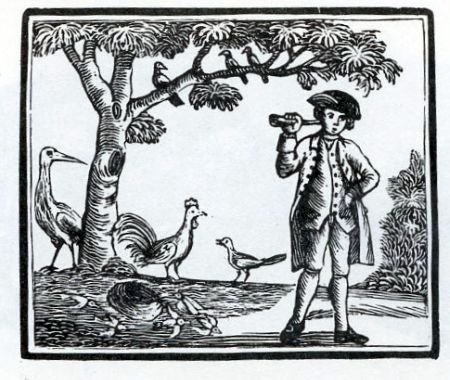April 9
Posted by sydney on Apr 9th, 2009

From the studio of Thomas Bewick, for a very bird-y edition of the journals today.
- 1793: April 9, 1793 – Thomas Knight, a sober hind, assures us, that this day on Wish-hanger Common between Hedleigh & Frinsham he was several Bank Martins playing in & out, & hanging before some nest-holes in a sand-hill, where these birds usually nestle. This incident confirms my suspicions, that this species of Hirundo is to be seen first of any; & gives great reason to suppose that they do not leave their wild haunts at all, but are secreted amidst the clefts, & caverns of these abrupt cliffs where they usually spend their summers. The late severe weather considered, it is not very probable that these birds should have migrated so early from a tropical region thro’ all these cutting winds and pinching frosts: but it is easy to suppose that they may like bats & flies, have been awakened by the influence of the Sun, amidst their secret latebrae, where they have spent the uncomfortable foodless months in a torpid state, & the profoundest of slumbers. There is a large pond at Wish-hanger which induces these sand-martins to frequent that district. For I have ever remarked that they haunt near great waters, either rivers or lakes. Planted in one of the quarters of the garden, in ground well-dunged, 8 long rows of potatoes. Carted in hot dung for the cucumber-bed.
- 1792: April 9, 1792 – Nightingale sings. Cuckoo is heard. Timothy the tortoise weighs 6 ae 11 1/2 oz.
- 1789: April 9, 1789 – Brimstone butter-fly. The tortoise comes out. Dog violets blow. Summer-like.
- 1787: April 9, 1787 – Sun, sharp wind.
- 1783: April 9, 1783 – Red-start at Selborne.
- 1776: April 9, 1776 – Young geese & ducks. Four swallows at Alton.
- 1774: April 9, 1774 – The ring-ouzel appears on it’s spring migration. It feeds now on ivy-berries, which just begin to ripen. Ivy blossoms in Octobr. In the autumn it feeds on haws, yew berries, &c.: also on worms, &c.
- 1772: April 9, 1772 – Titlark whistles.
- 1771: April 9, 1771 – Wryneck pipes about in orchards.
- 1770: April 9, 1770 – No birds sing, & no insects appear during this wintry, sharp season.
- 1769: April 9, 1769 – Atricapilla. The black-cap is usually the second bird of passage that appears. Some snow under the hedges.
- 1768: April 9, 1768 – The titlark, Aladua pratorum, first sings. It is a delicate songster; flying from tree to tree, & spreading out it’s wings it chants in it’s descent. It also sings on trees, & on the ground walking in pasture fields.
 Theme Ported to
Theme Ported to